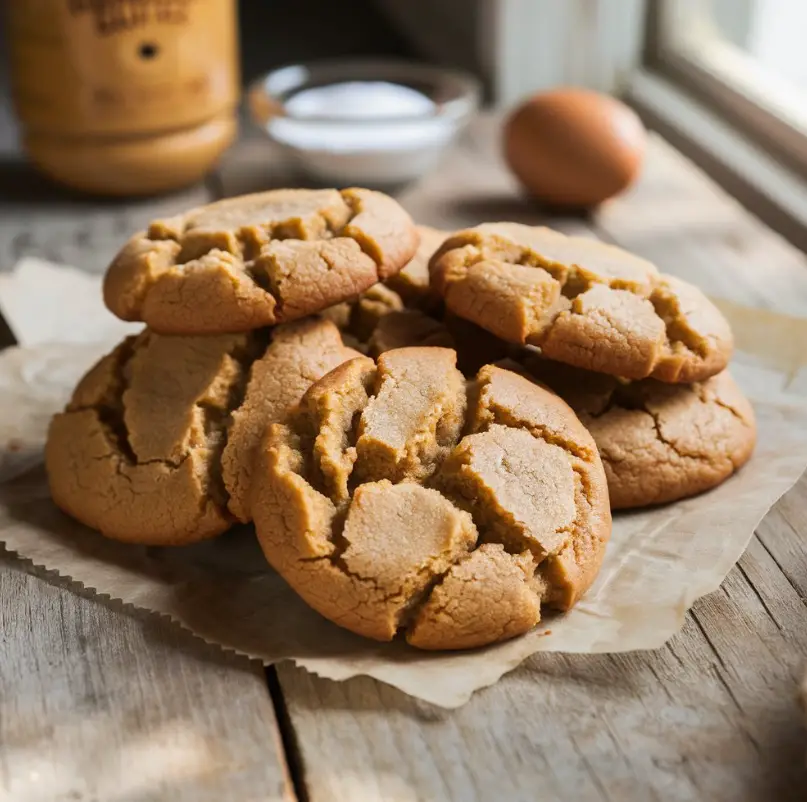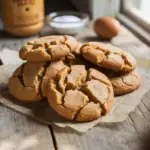Table of Contents: Why Are My 3 Ingredient Peanut Butter Cookies Falling Apart?
Introduction: Why Are My 3 Ingredient Peanut Butter Cookies Falling Apart?
There’s nothing worse than pulling a batch of peanut butter cookies out of the oven, only to watch them crumble into a pile of delicious but infuriating crumbs. Trust me—I’ve been there! These 3 Ingredient Peanut Butter Cookies are supposed to be foolproof: creamy, sweet, and ready in 15 minutes. They’re the ultimate lazy-day treat, loved by kids and adults alike for their simplicity. But if yours keep falling apart, you’re not alone.
Fun fact: The first peanut butter cookie recipe appeared in the early 1900s, and bakers have been obsessed with their melt-in-your-mouth texture ever since. Unlike my fussy 5-Ingredient Chocolate Chip Cookies, these cookies require zero chill time or fancy tools—just a bowl, a fork, and a craving for something sweet. But even the simplest recipes can go sideways. The good news? I’ve cracked the code to fixing crumbly cookies for good. Let’s rescue your batch and turn those kitchen fails into perfectly sturdy, crave-worthy treats!
What Are 3 Ingredient Peanut Butter Cookies?
Let’s address the elephant in the room: Why are they called “3 Ingredient Peanut Butter Cookies”? Is it because they’re so easy even a toddler could make them? (Spoiler: Yes.) Or because they’re the ultimate “I forgot dessert but need to impress guests” lifesaver? (Also yes.) Legend has it the name started as a dare: “Bet you can’t make cookies with just peanut butter, sugar, and an egg.” Challenge accepted!
These cookies prove that sometimes, less truly is more. Forget the saying “the way to a man’s heart is through his stomach”—this recipe is the way to everyone’s heart. Ready to stop crying over crumbly cookies and start baking like a pro? Let’s dive in!
Why You’ll Love This Recipe
- Simplicity Wins: No flour, no butter, no mixer—just three pantry staples. Perfect for last-minute cravings or baking with kids!
- Budget-Friendly: Skip the $6 bakery cookies. This recipe costs pennies per serving.
- Customizable Crunch: Roll them in sugar for sparkle, add chocolate chips, or drizzle with melted chocolate. They’re a blank canvas for creativity!
If you loved my 2-Ingredient Peanut Butter Fudge, you’ll adore these cookies. They’re just as easy but twice as fun to make. Grab your apron—it’s cookie time!
How to Make 3 Ingredient Peanut Butter Cookies

Quick Overview
Ready in 15 minutes, these cookies are crispy on the edges, chewy in the center, and impossible to mess up—if you follow my fixes below!
Key Ingredients
- 1 cup creamy peanut butter (not natural—stick to Skippy or Jif!)
- 1 cup granulated sugar (plus extra for rolling)
- 1 large egg
Step-by-Step Instructions
- Mix It Up: Preheat oven to 350°F. In a bowl, stir peanut butter, sugar, and egg until smooth.
- Roll & Press: Shape dough into 1-inch balls, roll in sugar, and place on a baking sheet. Use a fork to press crisscross patterns (this prevents spreading!).
- Bake: 10–12 minutes until edges golden. Let cool completely on the sheet—this is the secret to sturdy cookies!
What to Serve With Peanut Butter Cookies
- Classic Combo: A cold glass of milk or hot coffee.
- Dessert Upgrade: Crumble over vanilla ice cream.
- Savory Twist: Pair with sharp cheddar for a sweet-salty snack.
Top 3 Fixes for Crumbly Cookies
- Use the Right Peanut Butter: Natural brands separate—opt for processed (like Jif) for binding power.
- Don’t Skip the Egg: It’s the glue! For vegan cookies, swap in a flax egg.
- Cool Completely: Patience, friend! Let cookies firm up on the baking sheet for 10 minutes.
Storing and Reheating Tips
- Store: Keep in an airtight container for up to 5 days.
- Freeze: Dough balls last 3 months—bake straight from frozen!
- Reheat: 10 seconds in the microwave revives that gooey center.
FAQs: Why Are My 3 Ingredient Peanut Butter Cookies Falling Apart?
Q: Can I use natural peanut butter?
A: Unfortunately, natural peanut butter (the kind that separates) is the #1 culprit for crumbly cookies! It lacks the stabilizers in processed brands like Jif or Skippy, which help bind the dough. If you must use natural, stir it vigorously first and add 1–2 tbsp of flour.
Q: Can I make these vegan?
A: Absolutely! Swap the egg for a flax egg (1 tbsp ground flaxseed + 3 tbsp water, let sit 5 minutes). Just note: Vegan cookies may spread less, so flatten the dough balls slightly before baking.
Q: Why are my cookies too dry or too greasy?
A: Too dry? You overmeasured the peanut butter. Too greasy? Your peanut butter brand has extra oil. Fix it by adding 1–2 tbsp of oats or flour to balance the texture.
Q: Can I freeze the dough?
A: Yes! Roll the dough into balls, freeze on a tray, then transfer to a bag. Bake from frozen—just add 1–2 extra minutes.
Conclusion: Why Are My 3 Ingredient Peanut Butter Cookies Falling Apart?
Let’s be real: Baking should be fun, not frustrating. These 3 Ingredient Peanut Butter Cookies are meant to be easy, and with the fixes above, you’ll never stress over crumbly cookies again. Whether you’re whipping up a midnight snack, a lunchbox treat, or a last-minute dessert for guests, this recipe is your new best friend.
Remember, the magic lies in three things: the right peanut butter, patience while cooling, and that trusty egg (or flax substitute!). Once you nail these, you’ll have cookies that are crispy, chewy, and anything but fragile.
Print
BEST 3 Ingredient Peanut Butter Cookies
- Total Time: 15 minutes
- Yield: 18 cookies 1x
- Diet: Vegetarian
Description
These 3 Ingredient Peanut Butter Cookies are the ultimate fuss-free treat! Crispy edges, chewy centers, and ready in 15 minutes—perfect for beginners, busy days, or satisfying a sweet tooth. Say goodbye to crumbly disasters with foolproof tips!
Ingredients
- 1 cup creamy peanut butter (use processed brands like Jif or Skippy, not natural)
- 1 cup granulated sugar (plus extra for rolling)
- 1 large egg (or 1 flax egg for vegan: 1 tbsp ground flaxseed + 3 tbsp water)
Instructions
- Preheat oven to 350°F (175°C). Line a baking sheet with parchment paper.
- Mix dough: In a bowl, combine peanut butter, sugar, and egg until smooth and thick.
- Shape cookies: Roll dough into 18 small balls (1-inch), coat in sugar, and place on the baking sheet. Flatten gently with a fork in a crisscross pattern.
- Bake 10–12 minutes until edges turn golden. Let cool completely on the sheet to firm up.
Notes
- Vegan? Use a flax egg and ensure peanut butter is vegan-friendly.
- Crumbly dough? Processed peanut butter works best—natural varieties lack binding agents.
- Freeze dough: Roll into balls and freeze for up to 3 months. Bake from frozen (+1–2 minutes).
- Prep Time: 5 minutes
- Cook Time: 10 minutes
- Category: Dessert
- Method: Baking
- Cuisine: American
Nutrition
- Serving Size: 1 cookie
- Calories: 130
- Sugar: 11g
- Sodium: 60mg
- Fat: 7g
- Saturated Fat: 1.5g
- Unsaturated Fat: 4.5g
- Trans Fat: 0g
- Carbohydrates: 14g
- Fiber: 1g
- Protein: 3g
- Cholesterol: 10mg
Keywords: 3 ingredient peanut butter cookies, gluten-free cookies, easy dessert, quick cookies
